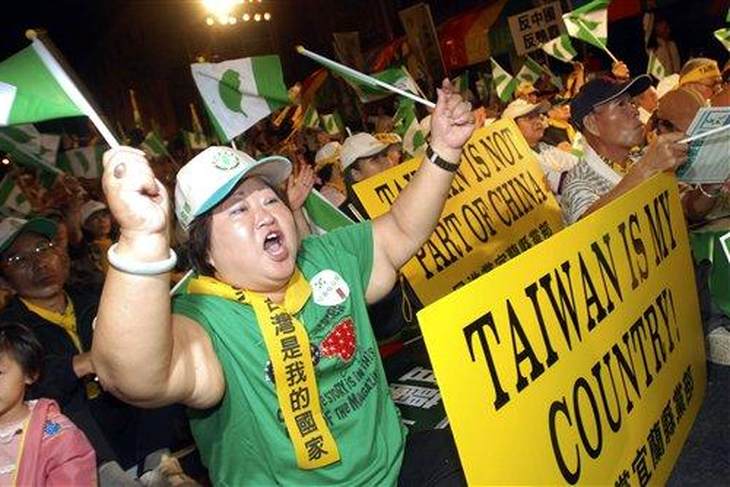
Article written by Richard Fernandez in "PJMedia":
The most likely detonator for major conflict with China is Taiwan. Hong Kong cannot be viably contested. India can defend itself.
Beijing would be foolish to rerun the Korean war. That leaves Taiwan. If Taiwan declares independence it might be enough to light the fuse because China has long declared that any such efforts would be met by force.
Before the pandemic Taiwan had little prospect of international support for independence. China was then the linchpin of globalism. There was too much for the rest of the world to lose by crossing Beijing. The virus changed all that. What everyone feared to lose has already been lost. In addition the Chinese Communist Party’s behavior has become a major political liability in Western capitals, and as the surprising support for a virus origin inquiry shows, even in non-Western capitals.
The changed atmosphere means that for the first time in decades Taiwan has a real opportunity to gain independence. The tides of history constantly shift. For some years they were flowing Beijing’s way. Now they have turned. For both sides it’s — perhaps — now or never.
This shipping stream was too valuable to disrupt in the days before the pandemic. The slump in trade caused by the pandemic has thinned Taiwan’s shipping shield. The trends that strengthen Taiwan’s diplomatic case for independence have weakened it’s naval position.
The most important aspect of this game is the critical first move is not Washington’s. The West cannot send troops to Hong Kong. China can. The West cannot invade China. China might invade Taiwan; Taiwan might declare independence. The US is reduced to a second mover.
Nevertheless China is unlikely to invade Taiwan in the early stages of any campaign. As a RAND study suggests, a multidivisional landing on Taiwan by Beijing is probably doomed until most of the defenses are beaten down. The Pentagon thinks China has nowhere near the resources to mount a major amphibious assault on Taiwan. They note that instead of amphibians Beijing is building a battlefleet.
“There is also no indication China is significantly expanding its landing ship force at this time – suggesting a direct beach-assault operation requiring extensive lift is less likely in planning,” the report states.
Instead, China’s recent spate of military exercises and the PLA Navy’s focus on building large aircraft carriers, escort cruisers and amphibious transport dock (LPD) ships suggest the military, for now, is geared toward blue water naval operations and smaller expeditionary missions.
This turn away mirrors the USMC’s own thinking about the declining practicability of Iwo Jima style landing operations in the 21st century. “Between ASCMs, ASBMs, submarines, and modern surveillance capabilities, the weapon engagement zone that amphibious assault ships would have to transit in order to be in a position to launch their smaller landing craft is being pushed out hundreds of nautical miles and beyond. That is simply too big of a vulnerability to accept.” It is far more likely that China, instead of attempting a landing, will either try to attain blue water supremacy (to solve the problem of a USN blockade across the Pacific and Indian oceans) or stifle Taiwan with mines.
In mid-2018, the Chinese navy conducted one of the largest mine warfare exercises in living memory, involving some 60 minelayers and minesweepers, aircraft and submarines practising laying and countering live mines. This unprecedented exercise, supported by some of China’s top scientists and mine development specialists, increased the already growing unease about China’s expansion into the South China Sea.
Some 10 years ago, a US Naval War College study revealed that China possessed over 100,000 sea mines, and that their use was fundamental to its strategy of constraining US naval forces operating in Beijing’s area of interest. While, at the time, most strategists saw this as a direct reference to the Taiwan Strait and North Korea, that’s no longer so.
The PLA’s unmatched conventional ballistic-missile arsenal and rapidly evolving military capabilities, combined with a perception of relative invulnerability to U.S. retaliatory strikes, could lure Chinese leaders into a belief that a conventional first strike might deliver temporary PLA regional superiority, during which time Chinese leaders could settle regional disputes coercively, on their terms.Instead of a doomed attack across the straits a first strike could probably be directed at Guam and Japan with incalculable results. As Pearl Harbor, the Korean War, the Fall of the Soviet Union, 9/11 and the Coronavirus showed, Washington and the media rarely anticipate a crisis. The Pacific Rim bears watching even as America is transfixed by its domestic troubles.
https://pjmedia.com/columns/richard-fernandez/2020/05/31/another-potential-risk-from-china-n459413
